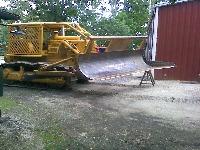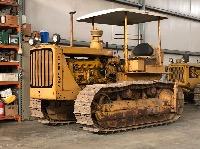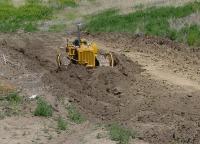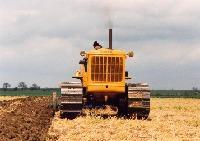- Posts: 6115
- Thank you received: 999

ACMOC Membership Benefits
- FREE quarterly magazine filled with content about antique Caterpillar machines
- FREE classified listings
- ACMOC store discounts and specials
- Full Bulletin Board Access
- Marketplace (For Sale/Wanted)
- Technical Library
- Post attachments
$44 /year ELECTRONIC
$60 /year USA
$77 /year International
Killefer disc harrow
www.ebay.com/itm/404018192959?hash=item5...tkp%3ABk9SR7bCs5PiYQ
Please Log in or Create an account to join the conversation.
THANK YOU!
AWESOME!
JM
Please Log in or Create an account to join the conversation.
Please Log in or Create an account to join the conversation.
Please Log in or Create an account to join the conversation.
Well, I could not download my Killefer photos but it is not a disc. I think that the disc showing is probably older than 1949. I believe that John Deere bought Killefer before that and stated painting them green. My Killefer as a data plate that reads, "Model 265,#120". I also have a newer tool carrier that is a John Deere Killefer and is Model 2-02. I have not found out anything on the early one and only a little on the later one.
Fred, do you know of any websites or groups that have information on the Killefers? I have not found any. Thanks Grant.
RE Deere owning Killefer prior to 1949 I think is correct as the John Deere General Catalog #200 in 1940 lists Killefer in LA as one of 12 John Deere manufacturing sites at that time. It says Killefer was established in 1890. Don't know anything more than that.
ACMOC Member 27 years
D47U 1950 #10164
Cat 112 1949 #3U1457
Cat 40 Scraper #1W-5494
Please Log in or Create an account to join the conversation.
John Gaunt, ACMOC Director, UK
Please Log in or Create an account to join the conversation.
Does anybody know when John Deere started building the 1200 disk and when they stopped building the oil bath disk and when the 1500 came out? These later 1200 and 1500 bearings are better and longer lasting than any new sealed bearing disk I have seen.
***I can't answer your question Mr. 17A, but I definitely agree, the 1200 series is a darned good disk. I only use one oil bath 1100-15 here, and noticed a 1200 won't plug itself as easily, just because of the way the series of spacers and blades are. I think modern day farmers like buying "new" is because most disks come with sealed bearings reducing the need for someone with a grease gun on a daily basis. High speed is another factor; IH Unibeam disks are good too, but due to the design for flex of the wider units, it will not cut "flat"/smooth and create a crown or uneven swath when pulled by huge horsepower at speeds in excess of 4 mph; add to the fact that they were never designed for such speed, the bearings would burn up quickly, especially if the user did not keep decent diameter blades on them. Seen many here that would run a disk (attempt to) with blades worn down to almost nothing, and the spools would be dragging and bearings eaten up constantly. Ugh. As frugal as we were, we re-bladed a disk before 18" and often 20" was the limit. Had friends that would swap out blades from a large field disk that began as 26", worn to 22", then swap to an orchard disk! JM
***Could you show us what a 1500 series looks like? I am not familiar with that one; is it with inverted heavy angle iron frame and weight box? Thanks!***
Please Log in or Create an account to join the conversation.
- ctsnowfighter
-

- Offline
- Platinum Boarder
- User
- Posts: 1002
- Thank you received: 502
Example of Bearing failure, lack of grease was not the issue!
There is a huge amount of stress upon 3 ball bearings (single races) on a disc of this size and in very tough conditions - these bearings fail easily.
Also had a shaft break on another disc because previous operators did not routinely tap the blades as they greased and walked around. Loose blades are a recipe for disaster!
Good habit to bump the blades when doing your walk arounds.
As JM said -- lots of power and higher speeds have created more strain and stress on equipment. Also affect the final outcome of the finished job, sometimes due to speed the disc skips. This was not nearly the issue when Cat's were the normal power pulling discs, etc in the fields.
I do not ever recall having a cast iron bearing in cast saddle fail on a disc - even to the point disc blades almost straight and riding on the spools!
CTS
Please Log in or Create an account to join the conversation.
TK88 mentions bearings that sound similar to ones used on an Allis Chalmers disk. Very bullet proof.
Tenant farmer here asked me one day if his number one man serviced any of the equipment prior to using it; I said look at the security video yourself and see...operator walked around with a confused look and might have greased ONE fitting total. It's no wonder why his grease gun never needed fresh tubes of grease! BTW, he was no longer employed after that day. JM
Please Log in or Create an account to join the conversation.
- ctsnowfighter
-

- Offline
- Platinum Boarder
- User
- Posts: 1002
- Thank you received: 502
One of the keys - slow speeds!
Those AC discs were pretty tough.
CTS
Please Log in or Create an account to join the conversation.
ACMOC
Antique Caterpillar Machinery Owners Club
1115 Madison St NE # 1117
Salem, OR 97301
support@acmoc.org
"I became a member recently because the wealth of knowledge here is priceless."
- Chris R
"I also joined a year ago. had been on here a couple of times as a non-member and found the info very helpful so I got a one year subscription (not very expensive at all) to try it out. I really like all the resources on here so I just got a three year. I think its a very small price for what you can get out of this site."
- Jason N





